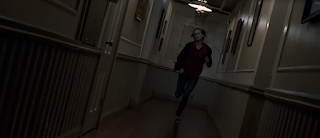5 Technical Conventions Often Used in Horror/Thriller Films
CANTED ANGLE
 The dutch or canted angle is a filming technique mostly used to convey confusion, disorientation, madness, or panic. It is mostly used in medium and long shots so that the rotating background sufficiently disorients the viewer. Typically, this technique creates a pronounced and obvious effect, so it is used sparingly and when it is the most meaningful.
The dutch or canted angle is a filming technique mostly used to convey confusion, disorientation, madness, or panic. It is mostly used in medium and long shots so that the rotating background sufficiently disorients the viewer. Typically, this technique creates a pronounced and obvious effect, so it is used sparingly and when it is the most meaningful.EXTREME CLOSE-UP
 The extreme close-up is almost exclusive to the horror genre. It tends to disturb the viewer. The normal audience member is uncomfortable with the intimacy of being that close to a subject; this can be used to increase the tension and create an unsettling feeling. Another use for it is to reveal a surprise. By starting very close up and slowly zooming out creates a suspenseful experience for the viewer. At first, the proximity makes the viewer question what they see. Next, as more details are shown, the viewer collects clues at what the subject might be. Finally, once the viewer's brain can make sense of the image, the viewer can put all the pieces together and understand the surprise. This keeps the audience entertained and engaged throughout the whole shot, as important events are uncovered.
The extreme close-up is almost exclusive to the horror genre. It tends to disturb the viewer. The normal audience member is uncomfortable with the intimacy of being that close to a subject; this can be used to increase the tension and create an unsettling feeling. Another use for it is to reveal a surprise. By starting very close up and slowly zooming out creates a suspenseful experience for the viewer. At first, the proximity makes the viewer question what they see. Next, as more details are shown, the viewer collects clues at what the subject might be. Finally, once the viewer's brain can make sense of the image, the viewer can put all the pieces together and understand the surprise. This keeps the audience entertained and engaged throughout the whole shot, as important events are uncovered.
SHALLOW DEPTH OF FIELD

Shallow depth of field means that the foreground will be in focus, but not the background. The background remains blurry, leaving all of the attention to what is in front. This is most commonly used in horror to inform the audience of a threat that may harm the character, while the movie's character continues to be unaware. The viewer is able to see the movements of a figure behind or around the character before they [the character] are able to. This is used to create anxiety, add uncertainty, and enhance the tension within the scene it is applied. By showing that there is something dangerous behind the character, the audience immediately wants to know when he/ she will notice, if they will get attacked obliviously, and what that vague figure is. (The GET OUT opening used shallow focus to show that that the seemingly irrelevant and innocent car that passed by actually turned around upon seeing Andre and was following behind him in his vehicle him as the character walked.)
LONG TRACKING SHOTS

Long tracking shots are effectively used in horror and suspense movies to create a feeling that the character is being followed or watched. The shot could be from the point of view of the attacker. This type of shot can also all about the setting, so it could also serve as a way to establish an eerie setting. These long takes are filled with suspense and tension that can be "exhausting". It is important that these takes are not too long, as to not overwhelm the audience to the point they no longer want to keep watching.

LOW KEY LIGHTING
Low key lighting can be achieved with a single light source that is typically dim and varies between soft and harsh. Low key lighting is extremely popular within the horror genre. Not only does it play with the common fear of the dark, but it creates drama and suspense. The shadows and silhouettes created by this type of lighting tend to scare people and can help exaggerate the movements of monsters, creatures, and characters. Not knowing exactly what is underneath a bed or behind a door at night will torment the viewer. Not being able to see the attacker and where it could attack tends to frighten them the most.
Sources:
https://www.videomaker.com/videonews/2012/11/6-reasons-to-get-an-extreme-closeup-shot
https://www.slideshare.net/amberloo20/codes-and-conventions-in-the-horror-genre
https://www.slideshare.net/EmmaWilkinson2/cinematography-focus-and-lighting-25798881
https://filmschoolrejects.com/the-narrative-immersion-of-the-tracking-shot/
https://www.youtube.com/watch?v=mkVYpzyJvG8&feature=emb_title
https://www.slideshare.net/EmmaWilkinson2/cinematography-focus-and-lighting-25798881
https://www.slideshare.net/billiewilson_/camera-shots-and-angles-for-a-horror-and-thriller-film

No comments:
Post a Comment